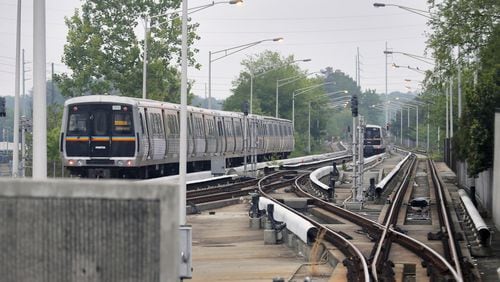An east-west transit line across the top of metro Atlanta would be financially sound and could happen relatively quickly, a study commissioned by seven metro Atlanta mayors concluded.
The project, which could eventually connect Northlake Mall in Tucker to Cumberland Parkway in Smyrna using managed lanes on I-285, is still in its preliminary stages. But those city leaders who have been championing an east-west connection said they were happy to learn that the concept was cost effective, as long as it didn't use fixed rails.
“It’s much more affordable than I think any of us dreamed,” said Rusty Paul, the mayor of Sandy Springs and one of the mayors involved in the discussions. “In my mind, it’s a doable project.”
Mayors from Cobb, Fulton and DeKalb counties have been involved in the discussions, and proposed stops along the route could include the Braves' SunTrust Park and The Battery, Roswell Road and I-285, Perimeter Mall and the Assembly project at the Doraville MARTA station.
The cities that are involved are Brookhaven, Chamblee, Doraville, Dunwoody, Sandy Springs, Smyrna and Tucker. The Cumberland and Perimeter Community Improvement Districts have also been partners.
The group still has to study how many people might use the transit option and has to determine how any transit expansion would be funded. The feasibility study presented last month concluded that running buses that look like trains to stations along the managed lanes planned for I-285 would cost about $450 million to build out, and could be operated for less than $8 million a year.
Heavy rail, the study said, could cost 10 times as much.
"We need to take this further, do further study," said Todd Long, the chief operating officer of Moreland Altobelli, one of the firms that presented the report. "I think [buses in managed lanes] is the future of transit for metro Atlanta because it's affordable, it's within reach."
Last summer, then-governor Nathan Deal announced the state would spend $100 million to help build four bus-only interchanges on Ga. 400.
John Ernst, the mayor of Brookhaven, convened the mayors' group to discuss their options. He said he saw the proposal as a way to counter the argument that MARTA doesn't go where people want to travel. If Gwinnett voters approve a plan to allow MARTA into their county in a vote next month, he said, this project could be part of a larger transit ecosystem that makes it more usable for everyone.
“Everyone talks about regionalism, but everything seems to stop at the county line,” Ernst said. “So far, people are excited by the proposition. We’re going to continue to study it and see what pops up.”
Joseph Hacker, a professor of planning and economic development at Georgia State University, said the proposal sounded “eminently sensible.” By using buses on lanes that are already being built, he said, governments can save money and roll out a solution relatively quickly. It can be flexible if one location isn’t as successful as others. And he said because the trips people want to take aren’t necessarily downtown, the project would connect people to places they want to go.
Hacker also praised the grassroots quality of the discussions, calling the proposal “the most progressive, sensible” transit discussion he’s heard in the region. Usually, he said, plans come down from the top. With local leaders promoting connectivity, he said, there’s a good chance of success.
“There’s a lot of power in these towns,” he said. “They’re growing. If they band together, there’s some possibilities there.”
The Georgia Department of Transportation still hasn’t received the mayors’ proposal, spokesperson Natalie Dale said. But Ernst, in Brookhaven, said the group got GDOT’s buy-in for the proposal “very quickly.” The I-285 project is expected to open in 2028.
Over the next several months, Ernst said, the mayors will look at potential ridership numbers and consider options to pay for the project. City sales taxes and capturing property value increases in the immediate areas are among the considerations, but any cross-jurisdictional agreement would have to be approved by the General Assembly. Ernst said nothing related to the project will be proposed this session.
Paul, in Sandy Springs, said there is “still a heavy lift” to convince people that the line would reduce congestion and improve the quality of life for residents. There’s still a lot of work to do before there’s a plan available, he said, but the proposal presents a rare opportunity to add infrastructure as redevelopment is happening, instead of letting the redevelopment conclude before looking at traffic.
“I think the feeling among the mayors is it’s a good idea,” he said. “We’re all going to have to hold hands and jump off together.”
About the Author








